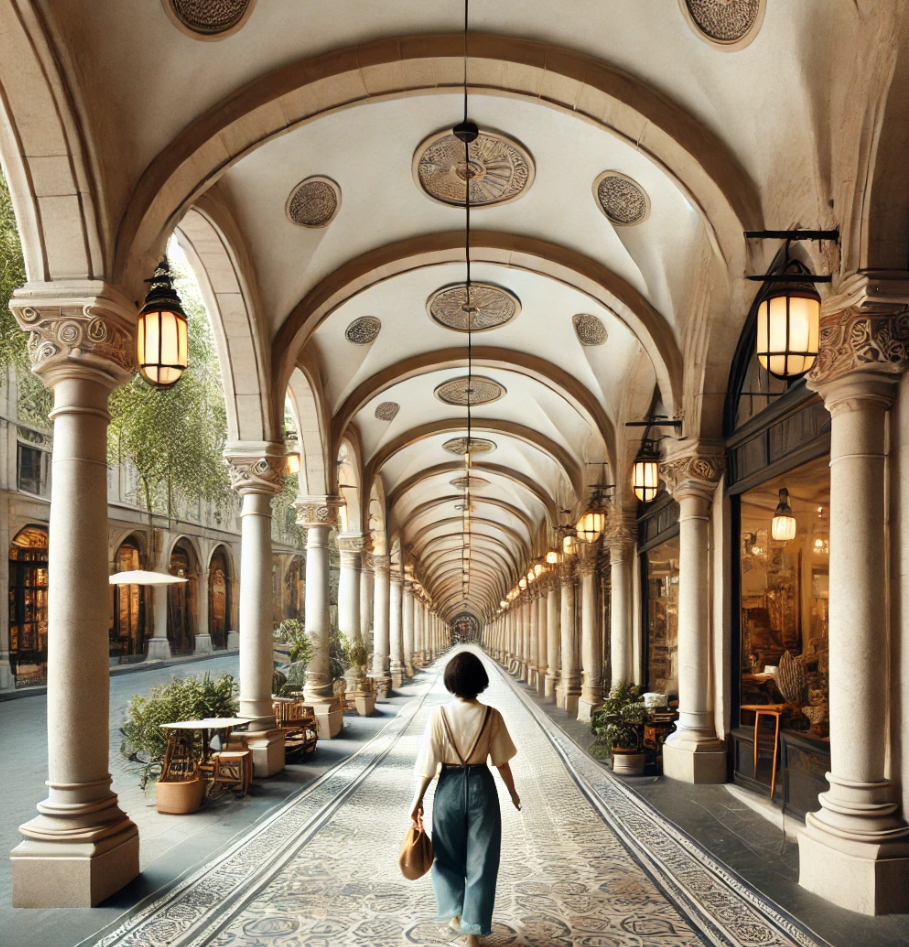ChatGPT:
Chiavari, Italy: Origin, History, and Development
Chiavari is a picturesque coastal town in the Liguria region of northern Italy, located along the Italian Riviera between Genoa and the Cinque Terre. With a historic center, elegant arcades, and a vibrant seaside promenade, Chiavari is known for its cultural heritage, artisanal craftsmanship, and relaxed Riviera atmosphere.
Origins and Early History
Chiavari’s history dates back to pre-Roman times when the area was inhabited by the Ligurian Tigullii, an ancient tribe known for their seafaring and trade activities. With the expansion of Roman influence, the region was integrated into the Roman Empire, and a settlement named Clavarium was established. The name possibly derives from the Latin clavis (key), suggesting its strategic importance.
During Roman rule, Chiavari was a minor but vital town along the coastal roads connecting Liguria with Tuscany and Gaul. However, after the fall of Rome in the 5th century, the region suffered invasions and instability due to barbarian incursions, including those by the Lombards and later the Saracens.
Medieval Growth and Genoese Domination
By the 12th century, Chiavari developed into a fortified town under the influence of the Republic of Genoa, which was expanding its control over Liguria. In 1178, it officially became part of Genoa’s territories, serving as an important trading and shipbuilding center.
During this period, Chiavari was fortified with walls and towers, remnants of which can still be seen today. It became known for its arcaded streets, a medieval urban design that still defines the town’s historic center. The Genoese influence also fostered the development of craftsmanship, particularly the production of the Chiavari chair (sedia di Chiavari), a light yet durable wooden chair designed in the early 19th century and admired for its elegance.
Renaissance and Economic Development
Throughout the Renaissance and Baroque periods, Chiavari thrived as part of the Genoese Republic’s trade network. The town benefitted from maritime commerce and agriculture, particularly the cultivation of olive trees and vineyards.
In the 18th century, Chiavari became more prominent as it gained administrative importance under Genoese rule. However, after the Napoleonic conquest of Liguria in the late 18th century, the region was incorporated into the Ligurian Republic and later annexed into the Kingdom of Sardinia in 1815, eventually becoming part of unified Italy in 1861.
Modern Development and Tourism
With the advent of the railway system in the 19th century, Chiavari became more accessible, contributing to economic growth. The town maintained its maritime traditions but also developed industries such as furniture-making, particularly the Chiavari chair, which gained international recognition.
During the 20th century, Chiavari transformed into a popular seaside destination, thanks to its sandy beaches, charming old town, and mild climate. While it remained a quieter alternative to the nearby Portofino and Cinque Terre, it attracted both Italian and international visitors.
Today, Chiavari is a mix of tradition and modernity, preserving its historic architecture, artisanal heritage, and coastal charm. It is known for its weekly markets, elegant arcades, and relaxed Riviera lifestyle, making it an appealing destination for those looking to experience authentic Ligurian culture without the crowds of more tourist-heavy locations.
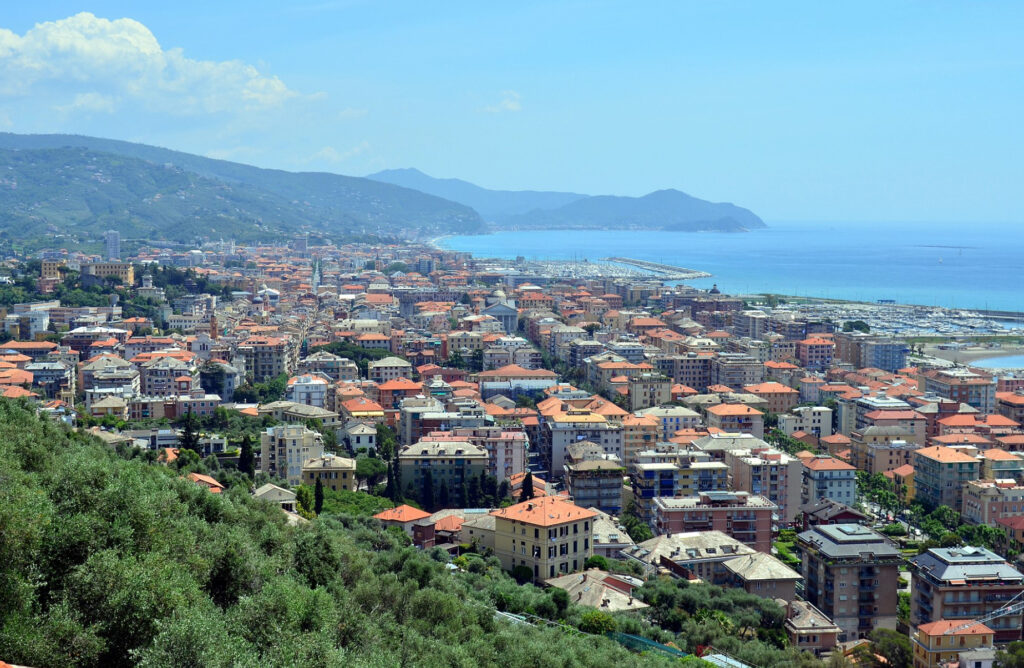
Origin and Characteristics of Arcaded Streets in Chiavari
The arcaded streets of Chiavari, known locally as “I portici” are one of the town’s most distinctive architectural features. These covered walkways, lined with shops and residences, date back to the Middle Ages, when the town was developing under the influence of the Republic of Genoa. Their design was influenced by both practical and aesthetic considerations, making them a hallmark of Chiavari’s urban identity.
Origin and Historical Development
Arcaded streets in Chiavari originated during the 12th and 13th centuries, a period when the town was expanding under Genoese rule. The construction of porticoes was encouraged for multiple reasons:
Protection from the elements: Chiavari, like much of Liguria, experiences strong coastal winds, rain, and summer heat. The arcades provided shelter for pedestrians and traders, allowing commerce to continue regardless of the weather.
Space optimization: Given the limited space in medieval walled towns, arcades allowed buildings to extend their upper floors over the public streets, maximizing the use of urban land while maintaining open walkways at ground level.
Commercial function: The ground floors of buildings along arcaded streets were traditionally occupied by workshops, artisan shops, and markets, creating a vibrant commercial hub protected from the sun and rain.
The arcades of Chiavari were heavily influenced by Genoese architecture, similar to those found in Genoa’s historic center and other Ligurian towns. Over time, they evolved into a refined urban element, blending Gothic and Renaissance styles.
Specific Characteristics of Chiavari’s Arcades
1. Continuous Covered Walkways
The arcades run along the main streets of Chiavari’s old town, most notably Via Martiri della Liberazione, the town’s central commercial artery.
These covered walkways are lined with arches supported by columns or pilasters, creating a rhythmic architectural pattern.
2. Diverse Architectural Styles
While medieval in origin, many arcades have been modified over the centuries, reflecting Gothic, Renaissance, and Baroque influences.
Some buildings feature ornate capitals, carved stone details, and painted frescoes on the archways, particularly in sections where aristocratic families once lived.
3. Material and Construction
The columns and arches are often made of local sandstone, giving them a warm, natural tone that complements the historic facades.
Some arcades feature low, wide arches, while others have narrower, pointed arches, reflecting the architectural evolution from medieval to later styles.
4. Integration with Commerce and Daily Life
Many of the arcades are home to traditional boutiques, bakeries, cafes, and artisan workshops, continuing their centuries-old function as a commercial space.
The arcades provide a shaded and cool environment, making them a social gathering place where locals and visitors can stroll, shop, and enjoy the town’s relaxed atmosphere.
Significance and Preservation
Chiavari’s arcades are not only a practical urban feature but also a symbol of the town’s history and identity. They reflect the town’s medieval roots while continuing to serve as a dynamic part of everyday life. Efforts have been made to preserve and restore these arcades, ensuring they maintain their historic charm while accommodating modern needs.
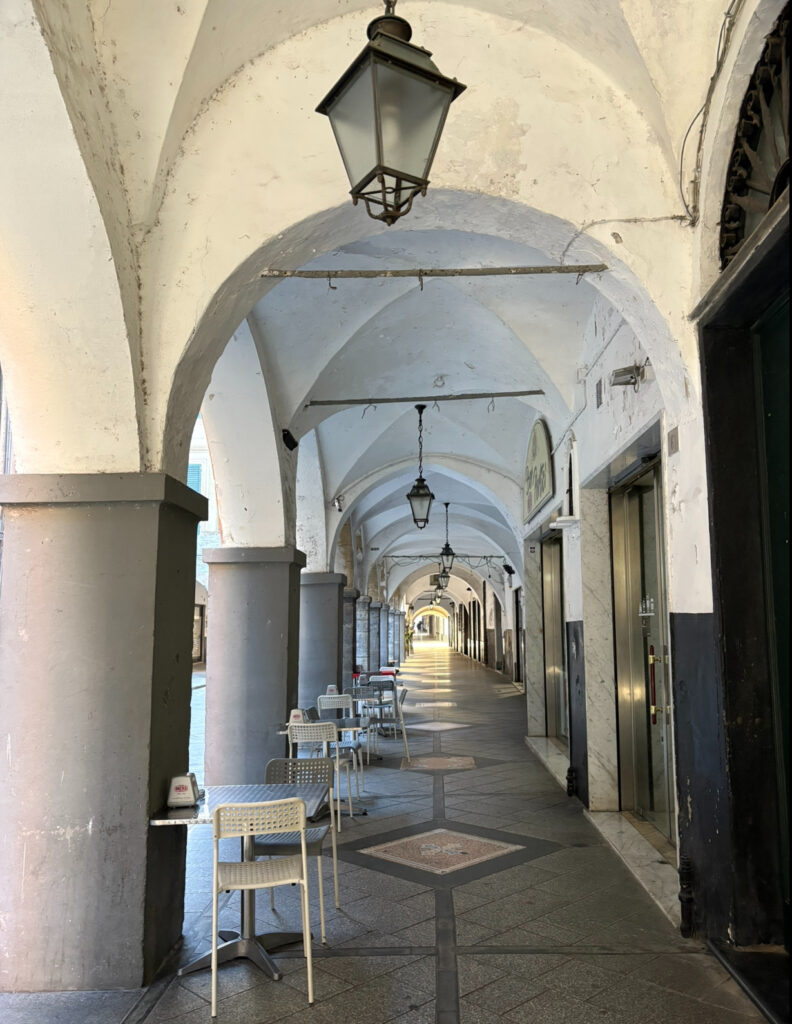
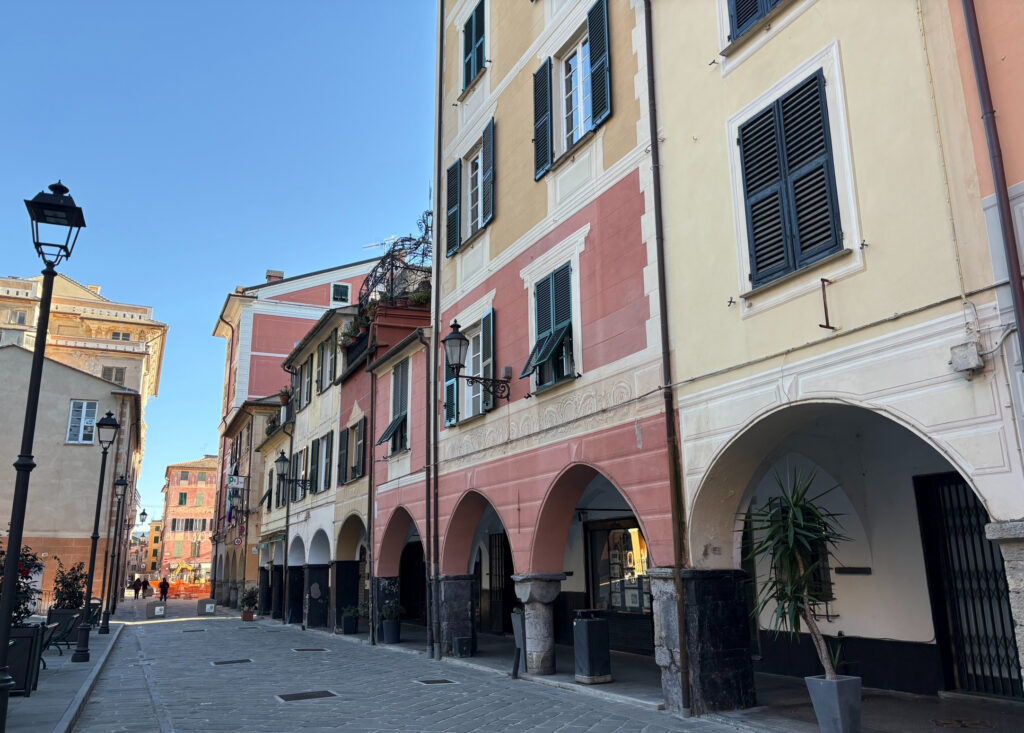
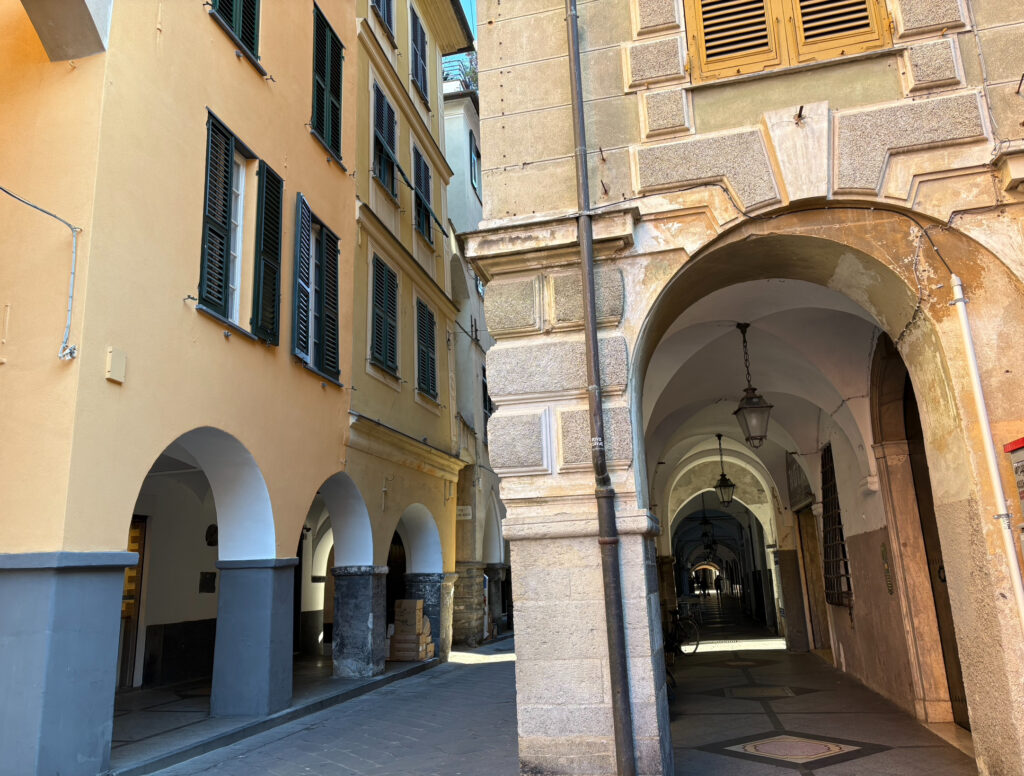
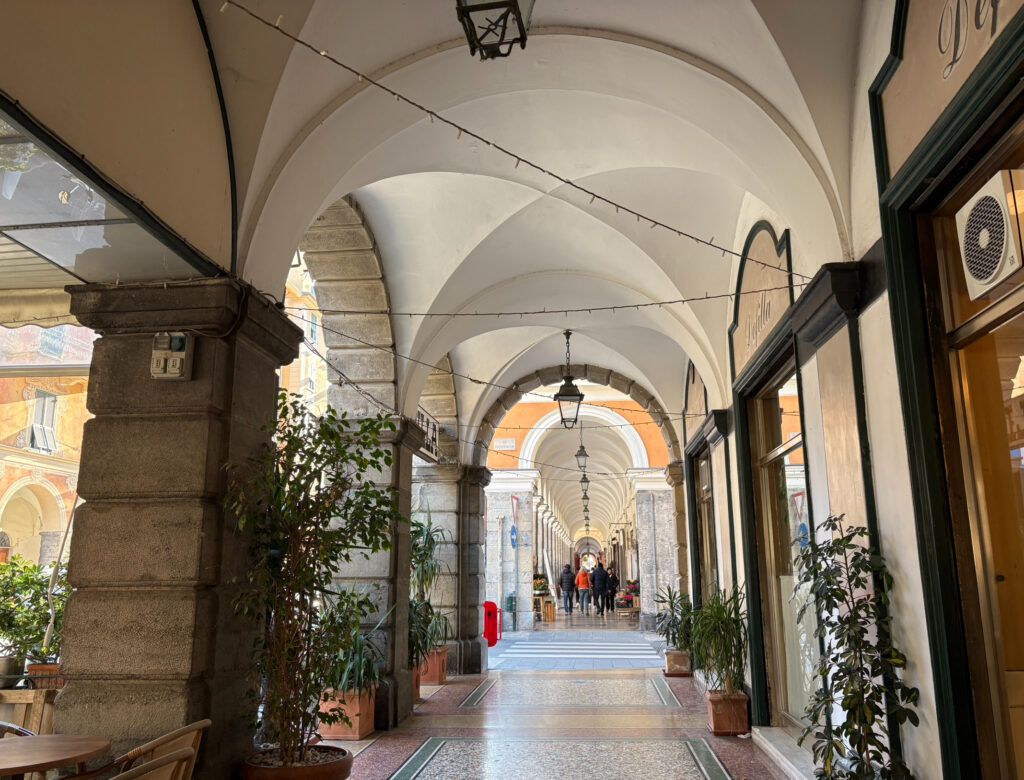
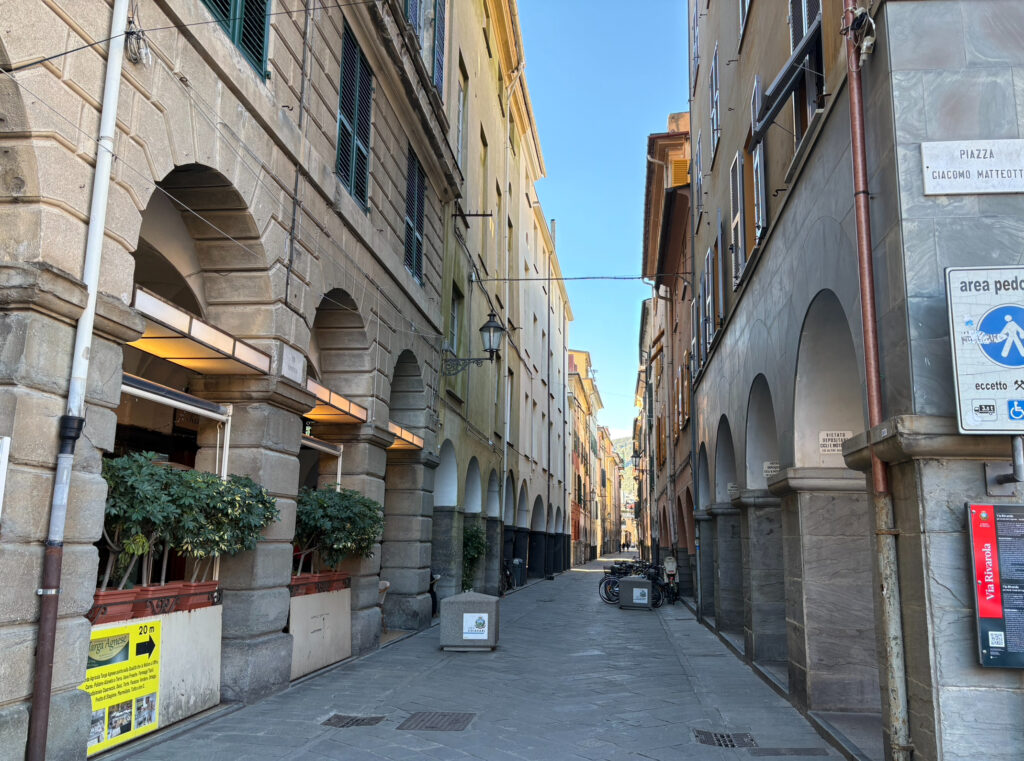
Historical Monuments and Tourist Attractions in Chiavari
Chiavari is more than just its arcaded streets—it boasts a variety of historical monuments, cultural sites, and scenic attractions. Here are the most notable ones:
- Palazzo Rocca and Rocca Gardens
• Why visit? A historic noble palace with beautiful gardens and an art museum.
• Highlights:
• The Neoclassical Palazzo Rocca, built in the 17th century for the noble Rocca family.
• The Civic Museum of Archaeology, housing artifacts from pre-Roman and Roman Liguria.
• The Rocca Gardens, featuring exotic plants, fountains, and a peaceful atmosphere.
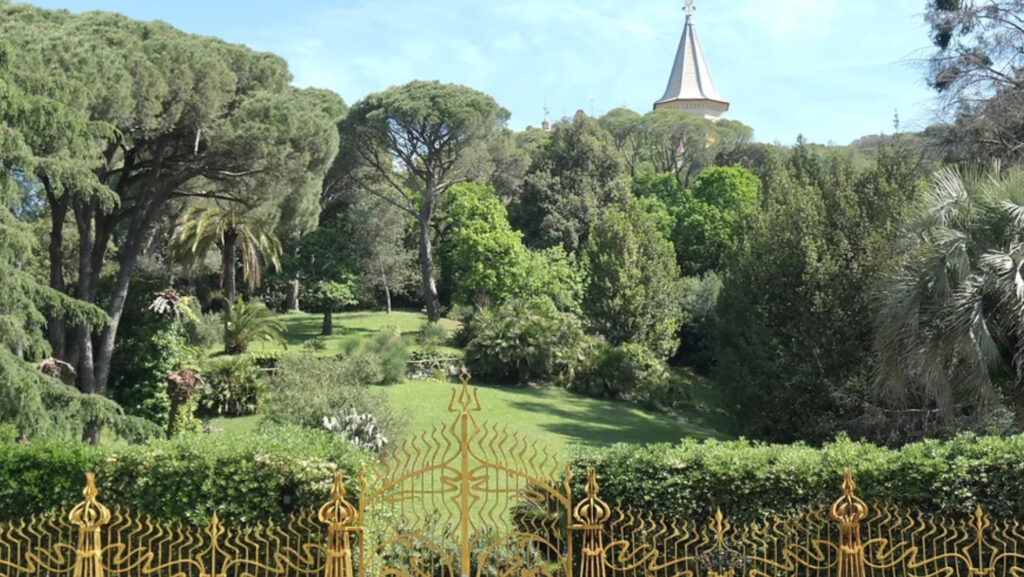
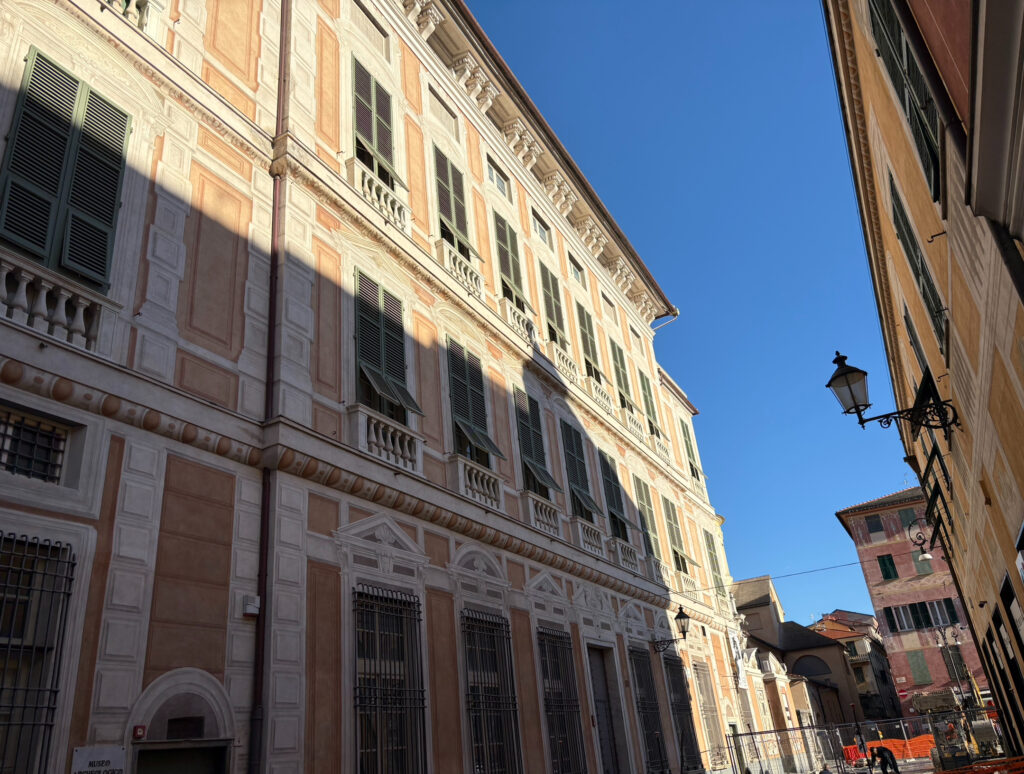
- Chiavari Cathedral (Cathedral of Nostra Signora dell’Orto)
• Why visit? A grand Neoclassical cathedral with stunning frescoes and an important religious history.
• Highlights:
• Built in the early 17th century, following an apparition of the Virgin Mary in a nearby orchard (orto).
• Impressive Corinthian columns and a grand dome.
• The interior features elaborate Baroque-style frescoes and marble altars.
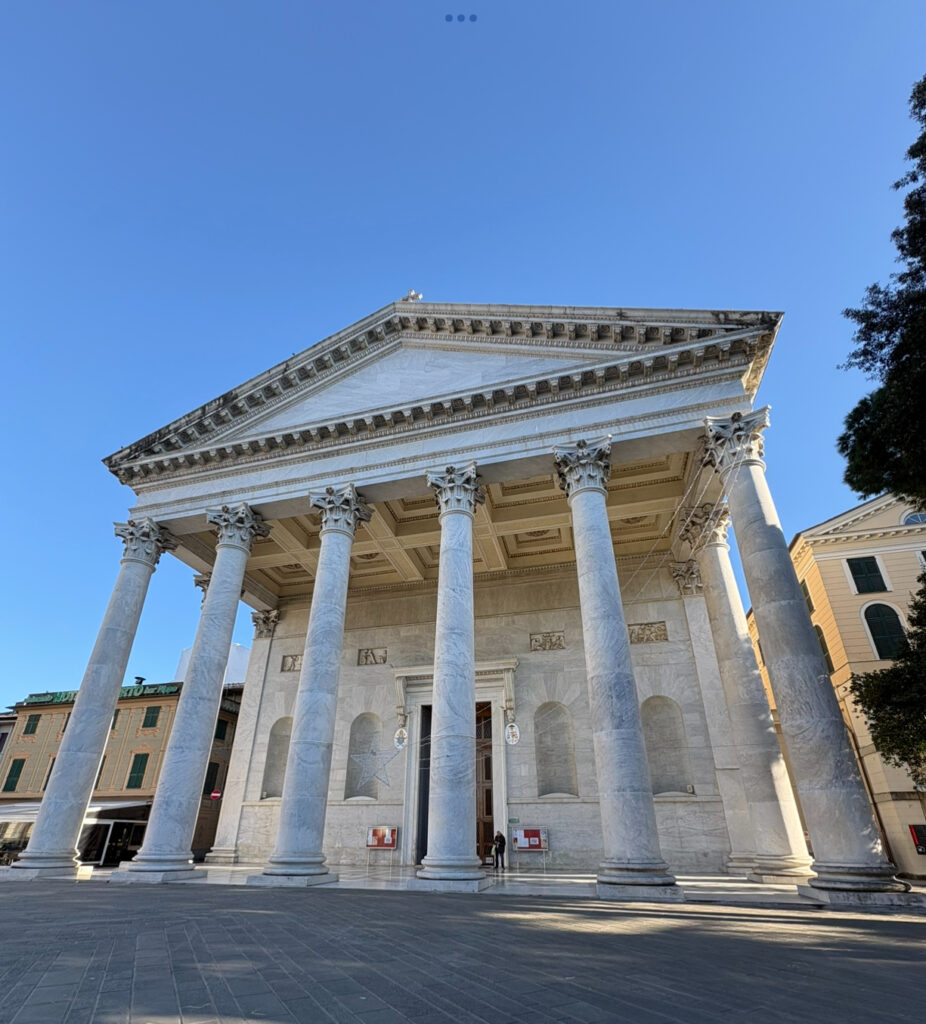
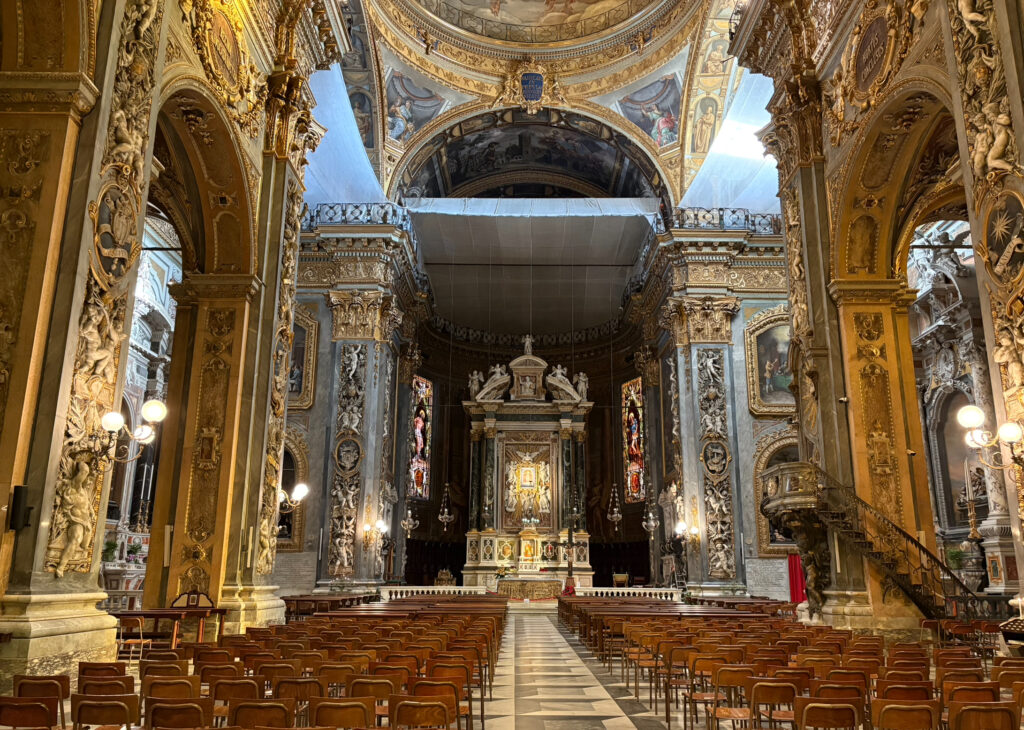
- Church of San Giovanni Battista
• Why visit? A fine example of Genoese Baroque architecture, located in the historic center.
• Highlights:
• Built in 1181, later transformed in the Baroque style in the 17th century.
• A richly decorated golden altar and detailed frescoes.
• Notable paintings by Genoese artists from the 16th and 17th centuries. - Porta di Santa Maria (Medieval City Gate)
• Why visit? One of the few surviving medieval gateways of Chiavari’s ancient fortifications.
• Highlights:
• Built in the 12th century as part of the defensive walls.
• Features a well-preserved stone archway with traces of old city walls.
• A good starting point for exploring the historic center. - Castello di Chiavari (Ruins of Chiavari Castle)
• Why visit? A medieval fortress offering panoramic views of the town and coastline.
• Highlights:
• Built in the 12th century as a defense against pirate raids.
• Today, only the ruins remain, but the site offers great views of the Gulf of Tigullio.
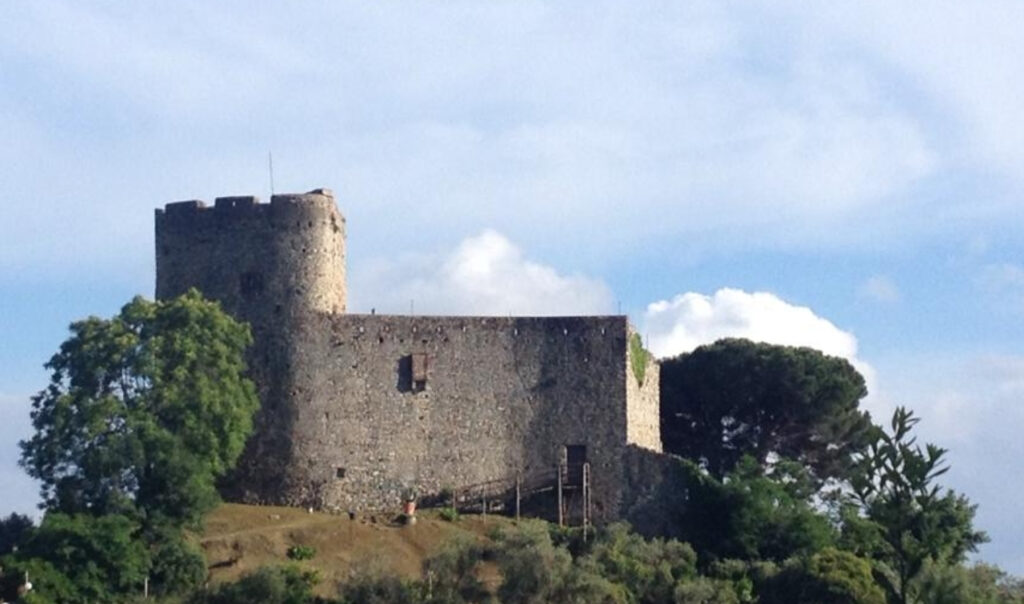
- The Fara Monument (Torre Fara)
• Why visit? A fascinating Art Deco tower with a unique history.
• Highlights:
• Built in the 1930s as a naval academy during the Fascist era.
• Later abandoned but recently restored and converted into luxury apartments.
• The area around it features a scenic seafront promenade. - The Marina and Seafront Promenade
• Why visit? A picturesque area perfect for a seaside stroll and fresh seafood.
• Highlights:
• Porto Turistico, a charming marina with boats and waterfront cafes.
• A scenic promenade with views of the Ligurian Sea.
• Ideal for an evening walk, with beautiful sunset views over the water.
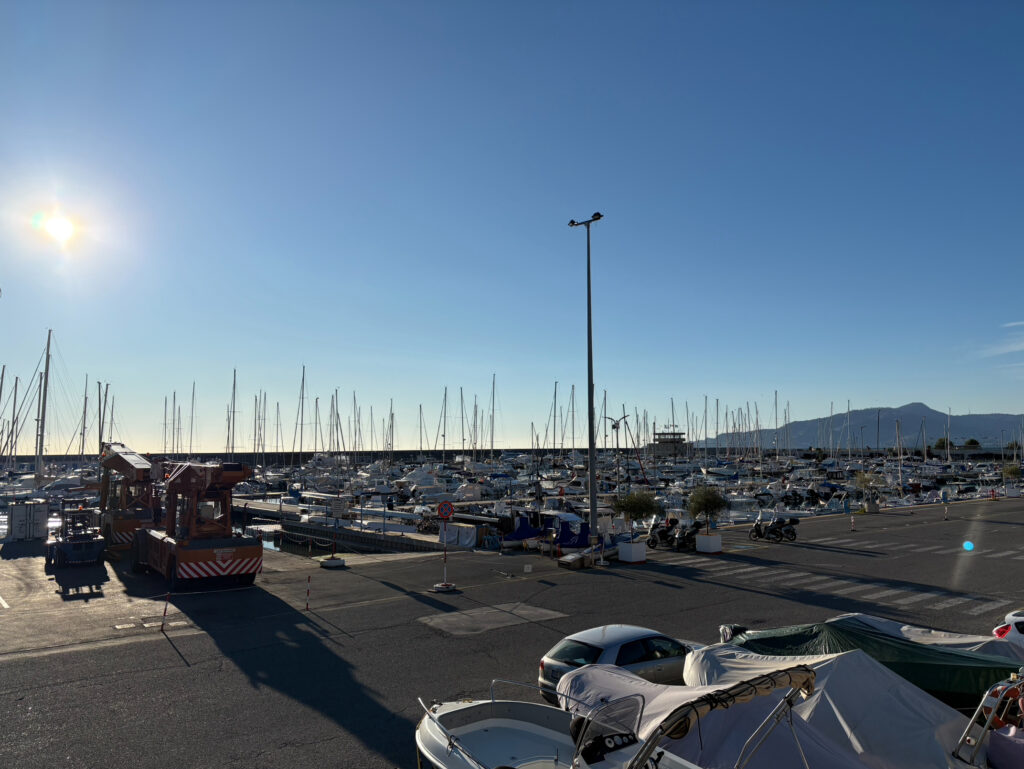
- Market Square (Piazza Mazzini)
• Why visit? A lively square with historic arcades, a covered market, and local atmosphere.
• Highlights:
• The weekly markets (Tuesdays and Fridays) selling fresh Ligurian produce.
• A historic stone loggia once used for civic gatherings.
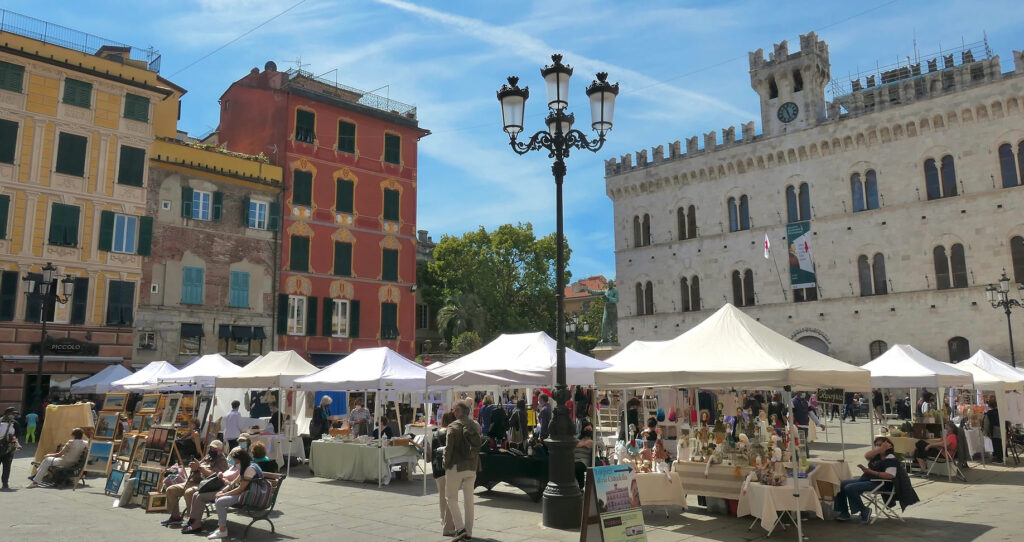
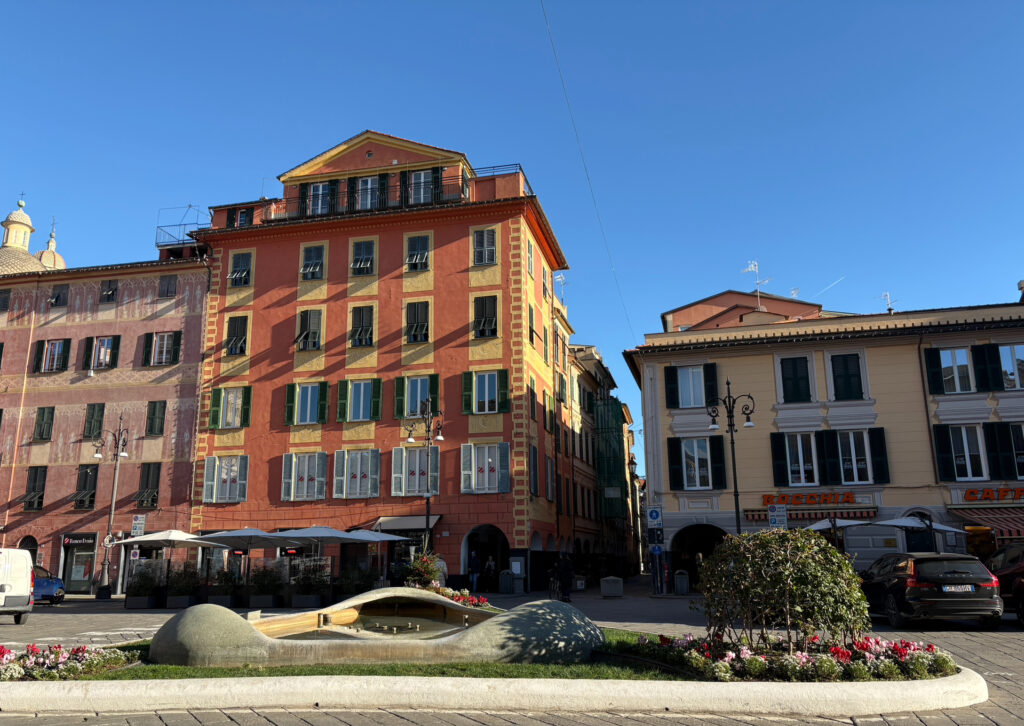
One-Day Itinerary for Visiting Chiavari
A perfect mix of history, architecture, seaside views, and local gastronomy.
Morning: Exploring the Historic Center & Breakfast
📍 Start: Piazza Mazzini (8:30 AM – 9:15 AM)
• Begin at Piazza Mazzini, the town’s main square, home to a historic covered market.
• If it’s Tuesday or Friday, stroll through the morning market to see local Ligurian products.
☕ Breakfast: Pasticceria Copello (9:15 AM – 9:45 AM)
• Try a focaccia di Recco, a thin and crispy cheese-filled focaccia, with a cappuccino.
• Alternatively, taste a panera, a traditional Ligurian coffee-flavored semifreddo.
Mid-Morning: Architecture & Historical Sights
📍 Via Martiri della Liberazione (Caruggio Dritto) – 9:45 AM – 10:30 AM
• Walk through Chiavari’s famous arcaded street, lined with artisan shops and historic buildings.
• Look for stores selling handmade Chiavari chairs, a local craft.
📍 Chiavari Cathedral (Nostra Signora dell’Orto) – 10:30 AM – 10:50 AM
• A grand Neoclassical cathedral with stunning frescoes and a connection to a 16th-century Marian apparition.
📍 Palazzo Rocca & Rocca Gardens (10:50 AM – 11:30 AM)
• Visit this elegant 17th-century palace, now an archaeological museum.
• Stroll through the beautiful gardens, a quiet oasis in the town.
📍 Porta di Santa Maria & Via Ravaschieri (11:30 AM – 12:00 PM)
• See one of Chiavari’s medieval gates, part of the old defensive walls.
• Walk down Via Ravaschieri, a noble street with well-preserved historic buildings.
Lunch: Traditional Ligurian Cuisine
📍 Osteria Da Vittorio (12:15 PM – 1:45 PM)
• A highly rated trattoria offering authentic Ligurian dishes.
• What to order:
• Trofie al pesto – Handmade twisted pasta with Ligurian basil pesto.
• Acciughe ripiene – Stuffed anchovies, a regional delicacy.
• Farinata – A chickpea pancake, crispy outside and soft inside.
• Pair with Vermentino white wine, a Ligurian specialty.
Afternoon: Coastal Views & Leisure
📍 Seafront Promenade & Marina (2:00 PM – 2:45 PM)
• Take a post-lunch walk along the Lungomare, enjoying views of the Ligurian Sea.
• Visit Porto Turistico, the marina with charming boats and cafes.
📍 Castello di Chiavari Ruins (2:45 PM – 3:30 PM)
• A short uphill walk leads to the remains of a medieval castle.
• Enjoy panoramic views over Chiavari and the Riviera.
Afternoon Café Break ☕
📍 Bar delle Carrozze (3:45 PM – 4:15 PM)
• A historic café in the arcaded streets.
• Try a canestrello, a traditional Ligurian butter cookie, with an espresso.
Late Afternoon: Torre Fara & Sunset Walk
📍 Torre Fara & Beachfront (4:30 PM – 5:30 PM)
• Visit the Art Deco Torre Fara, originally built as a naval academy.
• Walk along the beach area and enjoy the peaceful Riviera atmosphere.
Aperitivo & Dinner: A Perfect Ending
📍 Aperitivo at Cantina Reggiana (6:00 PM – 7:00 PM)
• A classic Ligurian wine bar serving local crostini, olives, and cured meats.
• Try Pigato or Rossese di Dolceacqua, excellent regional wines.
📍 Dinner at Hostaria Vecchia Chiavari (7:30 PM – 9:00 PM)
• Cozy restaurant with homemade Ligurian cuisine.
• Recommended dishes:
• Cappon magro – A traditional seafood and vegetable salad.
• Burrida di seppie – Cuttlefish stew with polenta.
• Torta pasqualina – A savory chard and ricotta pie.
Optional: Evening Stroll or Gelato
📍 Gelateria Lato G (9:00 PM – 9:30 PM)
• Try gelato al basilico, a unique local basil-flavored gelato.
• Enjoy a final stroll under the illuminated arcades before ending the day.
